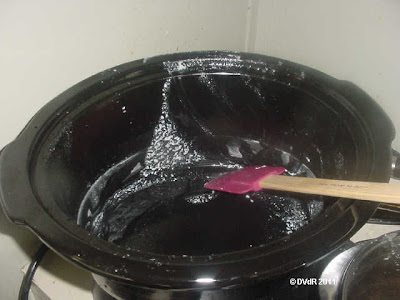I saved the whey from the fromage blanc I made, and decided to make ricotta since I don't have a pig to feed it to! Actually, I seldom use ricotta (probably because I don't know how), but I hate to waste anything... and ricotta can be frozen. Not all whey from cheesemaking is suitable for making ricotta... there is acid whey and sweet whey. If you have used an acid-base like lemons or vinegar to make mozzarella or Whole Milk Ricotta, it will not work for this whey ricotta.
However, if you have used a bacterial culture to make cheese, it should work fine, depending on the pH when you removed the curds. I'll do a post soon on the many uses of whey.
Here's what happens in this process: Once the curds have been removed from the whey, a lot of inoculated bacteria remain in the whey. If allowed to ferment for 12-24 hours, the remaining sugars are converted to lactic acid, lowering the pH of the whey and reducing the solubility of the proteins. Then when you heat it, the proteins become denatured, which causes them to precipitate out as a fine, small-grained curd, which can be filtered out.
However, if you have used a bacterial culture to make cheese, it should work fine, depending on the pH when you removed the curds. I'll do a post soon on the many uses of whey.
Here's what happens in this process: Once the curds have been removed from the whey, a lot of inoculated bacteria remain in the whey. If allowed to ferment for 12-24 hours, the remaining sugars are converted to lactic acid, lowering the pH of the whey and reducing the solubility of the proteins. Then when you heat it, the proteins become denatured, which causes them to precipitate out as a fine, small-grained curd, which can be filtered out.
Let the whey sit 12-24 hours to develop enough acidity to make ricotta.
The next morning, heat the whey, stirring frequently, to near boiling... about 203ºF. It will develop somewhat of a foam on the surface. I chose to use my slow cooker because it heats (on high) to just about 208ºF, and I didn't have to watch it, other than stirring occasionally.
Cover, and remove from the heat. DO NOT STIR. As it cools, it will develop sort of 'cloud' looking clumps in the whey, and the whey will take on a clear, yellowish-green hue. (The riboflavin in the whey gives it that color.) Let it set undisturbed until cool to the touch.
Once cool, set up a strainer or colander lined with fine cheesecloth, butter muslin, or a non-terry tea towel over a large pot or bowl to catch the liquid.
 |
| Residue in pot shows small curd size |
Carefully pour the small curds and whey into the cheesecloth and allow to drain. Because the small curds are so fine, it may take several hours to drain.
Once a lot of the liquid has drained off, you may pull together the corners of the cheesecloth and hang the "bag" over a sink or container to catch the remaining liquid. This may take several hours, or even overnight. If your room is warm, you might want to do this in the refrigerator. As you can see in the photo above, the leftover whey from my initial half-gallon of milk used to make the fromage blanc didn't make much ricotta... but I didn't waste the nutrients, either! (Mine is still hanging and draining 2 hours later; from the looks of the diminished size of the bag, I'd bet that there is not much more than ¼ cup of ricotta. Not much to show, but a good learning experience for almost no effort except hanging the bag.)
Will I do it again? Yes, but not with the scant amount of leftover whey from making Fromage Blanc, and probably not with any half-gallon batch. I've just started a 1 gallon batch of feta and will probably try the whey from it, just for giggles.
The remaining whey after making whey ricotta has very little protein in it, but still may be fed to a pig or chickens. I put mine on the garden; the microbes love it!
After the whey has stopped dripping out, put the ricotta in a bowl and add some fine-grained salt, to taste. It won't take much, maybe less than ¼ teaspoon for the whey from 1 gallon of milk. You could also add herbs now, depending on how you will use the ricotta.
Note: many recipes call for the addition of some cream, or whole milk, to the whey before heating. What many cheesemaking folks suggest is that the addition may make it creamier, but also more grainy. Since I have no frame of reference, I opted for the more traditional, old-school method, without any milk addition.
Update: While this post was sitting in the queue, I did make the gallon batch of feta, and tried again for some whey ricotta. It is draining as I'm writing this, and I think there will be more than a cup when it is finished. Since this batch apparently contained more milk proteins, it looked very much like egg drop soup as it cooled and I ladled off the clear whey on top.



No comments:
Post a Comment
I'd love to hear what you think about my posts! We all learn together.